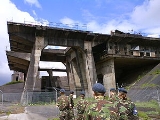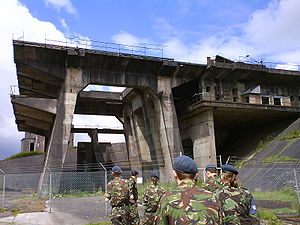
RAF Spadeadam
Encyclopedia
RAF Spadeadam is a Royal Air Force
station in Cumbria
, England
close to the border with Northumberland
. It is the home of the 9000 acre (36 km²) Electronic Warfare Tactics Range, making it the largest (by area) RAF base in the United Kingdom
.
 Its primary purpose is to provide a location for teaching electronic warfare
Its primary purpose is to provide a location for teaching electronic warfare
to RAF and other NATO aircrew. Spadeadam was remote and largely uninhabited until 1957 when the Intermediate Range Ballistic Missile Test Centre was built for the Blue Streak
Project. The RAF took it over in 1976 and it became Europe's first Electronic Warfare Tactics Range in 1977. The range contains ground-based electronics warfare equipment to act as a simulated threat to training aircrews. Some of the equipment was manufactured in the Soviet Union
; some simulates emissions from potential enemy systems. It also has real and dummy targets such as airfields, a "village" of portable buildings, tanks, aircraft and vehicle convoys.
The site's role in Britain's Cold War
nuclear weapons programme was made public in 2004 when tree-felling uncovered remains of abandoned excavations for a missile silo. A survey of the site by the RAF and English Heritage
has attempted to record and interpret what was previously so secret that no plans from the period exist. Spadeadam was chosen as a launch site because of its isolation combined with nearby infrastructure capable of supporting it with such as a plentiful water supply, access to the National Grid and road connections. A stretch of the road to the site from Gilsland
had to be bypassed to make access easier for heavy trucks and the abandoned section is still known as "half-shaft" due to its unfortunate effect on vehicle transmissions. Spadeadam was probably intended to be one of 60 launch sites along the east coast of England but these were never built and it was only used as a test facility for engine firings and testing electronics and ground installations.
 The Rocket Establishment, as it was called, was divided into five areas: an administration and assembly block, a British Oxygen Company compound for on-site liquid oxygen fuel manufacture, a component test area, the engine test area and the static firing stands.
The Rocket Establishment, as it was called, was divided into five areas: an administration and assembly block, a British Oxygen Company compound for on-site liquid oxygen fuel manufacture, a component test area, the engine test area and the static firing stands.
The engine test area at Prior Lancy Rigg consisted of four concrete stands into which the engines could be mounted for test firing. Three remain, copied from a Rocketdyne
design used at their California Santa Susana Field Laboratory
site; the fourth has been demolished. This lost stand seems to have been built to a different design, using an innovative application of pre-stressed concrete to contain liquid oxygen spills. The area is now managed by GL Noble Denton
, and used commercially for hazardous industrial tests.
Two rocket-firing stands themselves stood at Greymare Hills and were large enough to accommodate a full Blue Streak missile. All firings were controlled from command centre bunkers connected to the stands by tunnels or surface cabling ducts.
Construction of the site required hundreds of men, mostly Irish labourers who lived in a temporary settlement nearby which locals called 'Paddy's Camp'.
The outlying moorland landscape of the site is of increasing importance for its visual quality and for nature conservation. The area includes a pristine peat bog
, populations of all three species of British newt
and forestry habitat suitable for endangered red squirrel
s.
Royal Air Force
The Royal Air Force is the aerial warfare service branch of the British Armed Forces. Formed on 1 April 1918, it is the oldest independent air force in the world...
station in Cumbria
Cumbria
Cumbria , is a non-metropolitan county in North West England. The county and Cumbria County Council, its local authority, came into existence in 1974 after the passage of the Local Government Act 1972. Cumbria's largest settlement and county town is Carlisle. It consists of six districts, and in...
, England
England
England is a country that is part of the United Kingdom. It shares land borders with Scotland to the north and Wales to the west; the Irish Sea is to the north west, the Celtic Sea to the south west, with the North Sea to the east and the English Channel to the south separating it from continental...
close to the border with Northumberland
Northumberland
Northumberland is the northernmost ceremonial county and a unitary district in North East England. For Eurostat purposes Northumberland is a NUTS 3 region and is one of three boroughs or unitary districts that comprise the "Northumberland and Tyne and Wear" NUTS 2 region...
. It is the home of the 9000 acre (36 km²) Electronic Warfare Tactics Range, making it the largest (by area) RAF base in the United Kingdom
United Kingdom
The United Kingdom of Great Britain and Northern IrelandIn the United Kingdom and Dependencies, other languages have been officially recognised as legitimate autochthonous languages under the European Charter for Regional or Minority Languages...
.
History

Electronic warfare
Electronic warfare refers to any action involving the use of the electromagnetic spectrum or directed energy to control the spectrum, attack an enemy, or impede enemy assaults via the spectrum. The purpose of electronic warfare is to deny the opponent the advantage of, and ensure friendly...
to RAF and other NATO aircrew. Spadeadam was remote and largely uninhabited until 1957 when the Intermediate Range Ballistic Missile Test Centre was built for the Blue Streak
Blue Streak missile
The Blue Streak missile was a British medium range ballistic missile . The Operational Requirement for the missile was issued in 1955 and the design was complete by 1957...
Project. The RAF took it over in 1976 and it became Europe's first Electronic Warfare Tactics Range in 1977. The range contains ground-based electronics warfare equipment to act as a simulated threat to training aircrews. Some of the equipment was manufactured in the Soviet Union
Soviet Union
The Soviet Union , officially the Union of Soviet Socialist Republics , was a constitutionally socialist state that existed in Eurasia between 1922 and 1991....
; some simulates emissions from potential enemy systems. It also has real and dummy targets such as airfields, a "village" of portable buildings, tanks, aircraft and vehicle convoys.
The site's role in Britain's Cold War
Cold War
The Cold War was the continuing state from roughly 1946 to 1991 of political conflict, military tension, proxy wars, and economic competition between the Communist World—primarily the Soviet Union and its satellite states and allies—and the powers of the Western world, primarily the United States...
nuclear weapons programme was made public in 2004 when tree-felling uncovered remains of abandoned excavations for a missile silo. A survey of the site by the RAF and English Heritage
English Heritage
English Heritage . is an executive non-departmental public body of the British Government sponsored by the Department for Culture, Media and Sport...
has attempted to record and interpret what was previously so secret that no plans from the period exist. Spadeadam was chosen as a launch site because of its isolation combined with nearby infrastructure capable of supporting it with such as a plentiful water supply, access to the National Grid and road connections. A stretch of the road to the site from Gilsland
Gilsland
Gilsland is a village in northern England about west of Hexham, and about east of Carlisle, which straddles the border between Cumbria and Northumberland...
had to be bypassed to make access easier for heavy trucks and the abandoned section is still known as "half-shaft" due to its unfortunate effect on vehicle transmissions. Spadeadam was probably intended to be one of 60 launch sites along the east coast of England but these were never built and it was only used as a test facility for engine firings and testing electronics and ground installations.

The engine test area at Prior Lancy Rigg consisted of four concrete stands into which the engines could be mounted for test firing. Three remain, copied from a Rocketdyne
Rocketdyne
Rocketdyne was a Rocket engine design and production company headquartered in Canoga Park, California, United States. The company was related to North American Aviation for most of its history. NAA merged with Rockwell International, which was then bought by Boeing in December, 1996...
design used at their California Santa Susana Field Laboratory
Santa Susana Field Laboratory
The Santa Susana Field Laboratory is a complex of industrial research and development facilities located on a 2,668 acre portion of the Southern California Simi Hills in Simi Valley, California, used mainly for the testing and development of Liquid-propellant rocket engines for the United States...
site; the fourth has been demolished. This lost stand seems to have been built to a different design, using an innovative application of pre-stressed concrete to contain liquid oxygen spills. The area is now managed by GL Noble Denton
GL Noble Denton
-About GL Noble Denton:GL Noble Denton is the oil and gas business of Germanischer Lloyd , headquartered in Hamburg, Germany and London, UK...
, and used commercially for hazardous industrial tests.
Two rocket-firing stands themselves stood at Greymare Hills and were large enough to accommodate a full Blue Streak missile. All firings were controlled from command centre bunkers connected to the stands by tunnels or surface cabling ducts.
Construction of the site required hundreds of men, mostly Irish labourers who lived in a temporary settlement nearby which locals called 'Paddy's Camp'.
The outlying moorland landscape of the site is of increasing importance for its visual quality and for nature conservation. The area includes a pristine peat bog
Bog
A bog, quagmire or mire is a wetland that accumulates acidic peat, a deposit of dead plant material—often mosses or, in Arctic climates, lichens....
, populations of all three species of British newt
Newt
A newt is an aquatic amphibian of the family Salamandridae, although not all aquatic salamanders are considered newts. Newts are classified in the subfamily Pleurodelinae of the family Salamandridae, and are found in North America, Europe and Asia...
and forestry habitat suitable for endangered red squirrel
Red Squirrel
The red squirrel or Eurasian red squirrel is a species of tree squirrel in the genus Sciurus common throughout Eurasia...
s.

